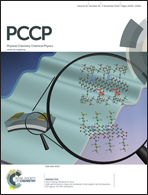Mode selective dynamics and kinetics of the H2 + F2 → H + HF + F reaction†
Abstract
The reaction between vibrationally excited H2 and F2 had previously been suggested to be a critical chain-branching step in the combustion of mixtures containing H2 and F2. In the present study, the vibrational state specific dynamics and kinetics for the reaction H2 + F2 → H + HF + F


 Please wait while we load your content...
Please wait while we load your content...